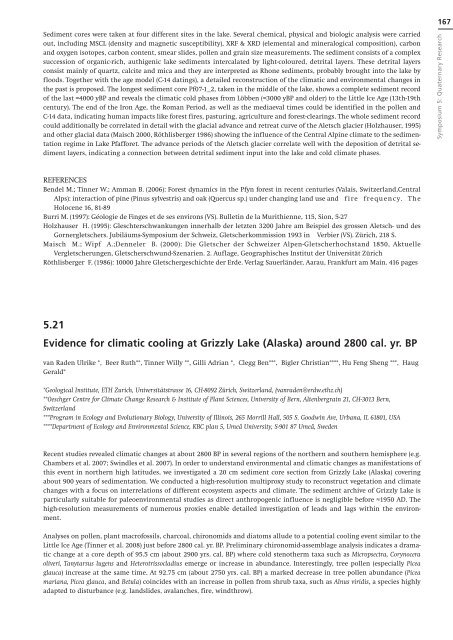Open Session - SWISS GEOSCIENCE MEETINGs
Open Session - SWISS GEOSCIENCE MEETINGs
Open Session - SWISS GEOSCIENCE MEETINGs
Create successful ePaper yourself
Turn your PDF publications into a flip-book with our unique Google optimized e-Paper software.
Sediment cores were taken at four different sites in the lake. Several chemical, physical and biologic analysis were carried<br />
out, including MSCL (density and magnetic susceptibility), XRF & XRD (elemental and mineralogical composition), carbon<br />
and oxygen isotopes, carbon content, smear slides, pollen and grain size measurements. The sediment consists of a complex<br />
succession of organic-rich, authigenic lake sediments intercalated by light-coloured, detrital layers. These detrital layers<br />
consist mainly of quartz, calcite and mica and they are interpreted as Rhone sediments, probably brought into the lake by<br />
floods. Together with the age model (C-14 datings), a detailed reconstruction of the climatic and environmental changes in<br />
the past is proposed. The longest sediment core Pf07-1_2, taken in the middle of the lake, shows a complete sediment record<br />
of the last ≈4000 yBP and reveals the climatic cold phases from Löbben (≈3000 yBP and older) to the Little Ice Age (13th-19th<br />
century). The end of the Iron Age, the Roman Period, as well as the mediaeval times could be identified in the pollen and<br />
C-14 data, indicating human impacts like forest fires, pasturing, agriculture and forest-clearings. The whole sediment record<br />
could additionally be correlated in detail with the glacial advance and retreat curve of the Aletsch glacier (Holzhauser, 1995)<br />
and other glacial data (Maisch 2000, Röthlisberger 1986) showing the influence of the Central Alpine climate to the sedimentation<br />
regime in Lake Pfafforet. The advance periods of the Aletsch glacier correlate well with the deposition of detrital sediment<br />
layers, indicating a connection between detrital sediment input into the lake and cold climate phases.<br />
REFERENCES<br />
Bendel M.; Tinner W.; Amman B. (2006): Forest dynamics in the Pfyn forest in recent centuries (Valais, Switzerland,Central<br />
Alps): interaction of pine (Pinus sylvestris) and oak (Quercus sp.) under changing land use and f ire frequency. The<br />
Holocene 16, 81-89<br />
Burri M. (1997): Géologie de Finges et de ses environs (VS). Bulletin de la Murithienne, 115, Sion, 5-27<br />
Holzhauser H. (1995): Gleschterschwankungen innerhalb der letzten 3200 Jahre am Beispiel des grossen Aletsch- und des<br />
Gornergletschers. Jubiläums-Symposium der Schweiz, Gletscherkommission 1993 in Verbier (VS). Zürich, 218 S.<br />
Maisch M.; Wipf A.;Denneler B. (2000): Die Gletscher der Schweizer Alpen-Gletscherhochstand 1850, Aktuelle<br />
Vergletscherungen, Gletscherschwund-Szenarien. 2. Auflage, Geographisches Institut der Universität Zürich<br />
Röthlisberger F. (1986): 10000 Jahre Gletschergeschichte der Erde. Verlag Sauerländer, Aarau, Frankfurt am Main. 416 pages<br />
.21<br />
Evidence for climatic cooling at Grizzly Lake (Alaska) around 2800 cal. yr. BP<br />
van Raden Ulrike *, Beer Ruth**, Tinner Willy **, Gilli Adrian *, Clegg Ben***, Bigler Christian****, Hu Feng Sheng ***, Haug<br />
Gerald*<br />
*Geological Institute, ETH Zurich, Universitätstrasse 16, CH-8092 Zürich, Switzerland, (vanraden@erdw.ethz.ch)<br />
**Oeschger Centre for Climate Change Research & Institute of Plant Sciences, University of Bern, Altenbergrain 21, CH-3013 Bern,<br />
Switzerland<br />
***Program in Ecology and Evolutionary Biology, University of Illinois, 265 Morrill Hall, 505 S. Goodwin Ave, Urbana, IL 61801, USA<br />
****Department of Ecology and Environmental Science, KBC plan 5, Umeå University, S-901 87 Umeå, Sweden<br />
Recent studies revealed climatic changes at about 2800 BP in several regions of the northern and southern hemisphere (e.g.<br />
Chambers et al. 2007; Swindles et al. 2007). In order to understand environmental and climatic changes as manifestations of<br />
this event in northern high latitudes, we investigated a 20 cm sediment core section from Grizzly Lake (Alaska) covering<br />
about 900 years of sedimentation. We conducted a high-resolution multiproxy study to reconstruct vegetation and climate<br />
changes with a focus on interrelations of different ecosystem aspects and climate. The sediment archive of Grizzly Lake is<br />
particularly suitable for paleoenvironmental studies as direct anthropogenic influence is negligible before ≈1950 AD. The<br />
high-resolution measurements of numerous proxies enable detailed investigation of leads and lags within the environment.<br />
Analyses on pollen, plant macrofossils, charcoal, chironomids and diatoms allude to a potential cooling event similar to the<br />
Little Ice Age (Tinner et al. 2008) just before 2800 cal. yr. BP. Preliminary chironomid-assemblage analysis indicates a dramatic<br />
change at a core depth of 95.5 cm (about 2900 yrs. cal. BP) where cold stenotherm taxa such as Micropsectra, Corynocera<br />
oliveri, Tanytarsus lugens and Heterotrissocladius emerge or increase in abundance. Interestingly, tree pollen (especially Picea<br />
glauca) increase at the same time. At 92.75 cm (about 2750 yrs. cal. BP) a marked decrease in tree pollen abundance (Picea<br />
mariana, Picea glauca, and Betula) coincides with an increase in pollen from shrub taxa, such as Alnus viridis, a species highly<br />
adapted to disturbance (e.g. landslides, avalanches, fire, windthrow).<br />
16<br />
Symposium 5: Quaternary Research









